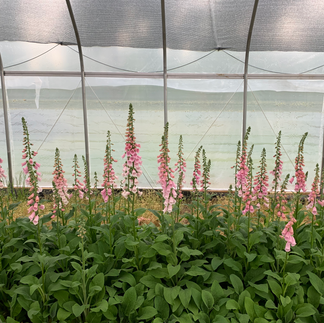
Autumn air has officially moved in, bringing its vibrant oranges, yellows, and reds to help the summer season wind down. Soon there will be a season of winter, of rest and of slow, gentle preparation for spring as those early flowers sit quietly and patiently wait for their turn to shine bright in our bouquets.
In order for those spring flowers to be ready for us, we plant those cool season varieties in the fall. Ranunculus, anemones, tulips, larkspur, bachelor buttons, feverfew, and foxglove are all varieties we’ve been tucking into the earth. Over the next month, we’ll be doing several rounds of successions for the plants to blossom steadily throughout spring and early summer. For homeowners looking to add any of these flowers to their cut flower garden, preparation may look a little different, so we will walk you through how to plant the same flowers we are currently planting in our fields and greenhouses.
Direct Seeding
Directly sowing seeds into the soil is definitely the simplest form of planting we do. Some of the varieties we direct seed include bupleurum, nigella, agrostemma, bachelor buttons and larkspur. Larkspur seeds in particular enjoy a chilling period for better germination, and the seeds are small enough that they are easy to store in your freezer or refrigerator. After chilling for a week or so, plant the seeds about ¼” deep. In our fields and tunnels, we like to mark a divet in the soil into which we drop the seeds. Once they’re on the ground, it's pretty well hands-off unless they need supplemental watering. It is important to note that this technique tends to require a lot more seeds than using seed starting in trays. We direct seed 5 rows that are 9 inches apart and use approximately 5,000 seeds per 25 feet. The seeds are sown thick, which sometimes means having to thin plants out once they have germinated. Most of the time, however, the flowers we direct seed can handle growing close with their neighbors. If you have a large space to cover, we recommend buying bulk. We like to use Johnny’s Seeds, which offers lots of variety and plenty of options for seed quantities. We have already sown our seeds this fall, but there’s plenty of time for home cut gardens!

Fall Planting of Bulbs
Another easy way to plant in the fall is planting bulbs. Tulips are one of our main bulbs we plant fresh every season. They require a chilling period before they are ready to bloom. This means they need to be exposed to cool temperatures of about 34-40 degrees for 6 to 12 weeks. To aid in their preparation, we often buy pre-chilled bulbs to make sure their chilling time is sufficient to provide earlier blooms. Our tulip bulbs typically come in at the end of October or early November. We find it best to tuck them in before the end of December for high quality spring blooms. Other bulbs we love are daffodils and allium. Because these flowers come back each year much more reliably than tulips, they have permanent homes on the farm. We like to build temporary raised beds for the tulips with frames that come apart easily after we’ve harvested all the bulbs. For home gardens however, the temporary frames aren’t necessary. Bulbs can be planted close together and should be about 6-8 inches deep.
Planting Corms

Our first succession of anemones is in the
greenhouse, with a round of ranunculus soon to follow. These two beauties are grown from corms, which differ from bulbs in their structure, being solid, modified stems. Bulbs are composed of layers also containing leaves. While both are very similar in the way they store energy, corms can be a little trickier than bulbs due to their tendency to rot if they stay too wet before leafing out. They arrive dry and shriveled, and require a soaking in water. After a few hours they will become plump up ready for planting. Starting in 50-cell trays allows us to keep the soil moisture more even to prevent rot. Once they leaf out, we transplant them into the greenhouses. While the sun does a great job of keeping these gems warm in the winter, we do use supplemental heating at night and on cloudy days to keep temperatures above freezing for earlier blooms. If you’re hoping to add ranunculus or anemones to your cut garden without a heated space, you’ll want to wait to start these guys in early spring. You can read a step-by-step guide on a previous post.
Fall Transplants

Transplanting is a great way to plant for several reasons. First, starting the seeds in trays gives you more control over the growing environment and seed count compared to direct seeding. Transplanting a fully sprouted plant also gives your plant an advantage over weeds that haven’t germinated yet. However, this process also requires a lot more space, effort, equipment, and time. We explain a lot more about methods of seed starting in a previous blog post. We’ve been in the process of transplanting over the past few weeks, planting feverfew, foxglove, dianthus, cerinthe, and orlaya. All of these are cool season varieties we like to plant in our unheated tunnels, although they do well outdoors as well if covered during intense cold spells.
Adding Cool Season Varieties to Your Cut Garden at Home
All in all, cool season flowers are a wonderful asset to bouquets and garden space and provide beautiful textures and colors to spring. No matter the type of flower or way of planting, there’s still plenty of time to get these flowers in the ground. Keep an eye out on social media and in email - we’ll be bringing tulip bulbs, ranunculus and anemone corms, and cool season seeds up to the shop soon for anyone interested in trying these beautiful spring blooms!



















Comments